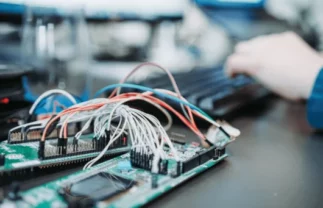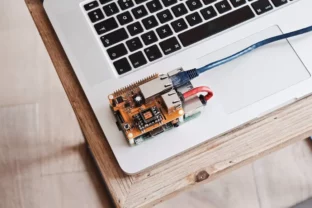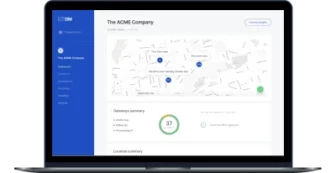
How to Ensure Remote Management of Large IoT Device Networks
The Internet of Things (IoT) has been in our lives for over two decades. The term was invented in 1999 to promote radio-frequency identification (RFID) technology. From 2008 to 2009, the number of things connected to the internet surpassed the number of individuals using it.
Since then, interconnected devices have become mainstream. Apple, Cisco, General Motors, and other tech giants are producing IoT sensors and devices. IoT technology has been adopted by nearly every industry: manufacturing, healthcare, logistics, energy, agriculture, smart cities… the list goes on.
In this post, we:
- give an overview of how IoT works
- explain the need for remote IoT system management and its benefits for different industries
- answer the question ‘how do IoT devices update remotely?’
- discuss how to enable secure management of IoT devices remotely
- describe a step-by-step approach to ensuring remote management of IoT over the internet
Read also: How an IoT supplier can build IoT software to attract new customers


How does an IoT system work?
Two components are mandatory to achieve universal object interaction via the internet:
IoT sensors
Sensors (also called end devices, physical devices, or nodes) detect various physical phenomena including heat, pressure, movement, humidity, and smoke. As sensors are expanding to new industries, the market is still growing, adding to the variety of sensors.
Sensors usually use a wireless connection to periodically send their data. As a rule, sensors must be as cheap as possible, non-volatile, autonomous, tailored to serve a specific function, and long-lasting. Considering their small size and the requirements above, enabling sensors to connect to the internet isn’t cost-effective or practical. That’s why sensors are commonly coupled with connectivity devices.
IoT connectivity devices
A separate group of IoT devices act like gateways or routers, serving as intermediaries between sensors and the internet. IoT connectivity devices can receive data from sensors using Bluetooth or specific 4G and IoT-oriented protocols that help to connect nodes to the internet, including LoRaWAN® and Sigfox.
Gateway devices collect data from sensors, pack that data, sometimes preprocess it, and send it to a web server where it’s processed. Collaborating with an experienced IoT software development company can further enhance the efficiency and reliability of these processes. Additionally, AI consulting services can help in leveraging machine learning algorithms for predictive maintenance and anomaly detection in IoT systems. This processing might result in:
- calculating statistics and trends
- initiating specific actions like turning on an irrigation system
- generating an alert in case of an emergency or anomaly
As one connectivity device can communicate with thousands of nodes, connectivity device manufacturers try to make these devices adaptive, autonomous, and reliable. Such a device might be equipped with a SIM card or have an Ethernet or Wi-Fi internet connection.
Also, such a device has more computing power than a sensor and can be remotely managed via the internet. The availability of these capabilities impacts the cost, as a rule making a connectivity device more expensive than a sensor.
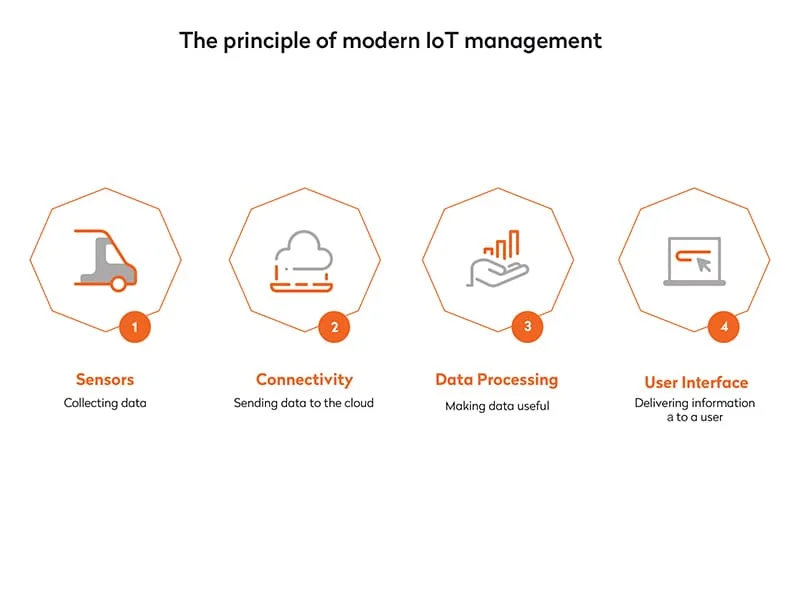
Recent innovations for improved IoT use
IoT sensors and connectivity devices are evolving. Manufacturers of such equipment are trying to expand and improve their adoption. For example, RAKwireless produces all classes of IoT devices for trending use cases and makes all its sensors compatible with all its gateways.
RAKwireless also provides IoT modules that have connectivity interfaces and several slots that can be equipped with various nodes. For instance, if you put a temperature sensor and a smoke detector into a module, you get a sophisticated fire detection system.
Additionally, the need for remote IoT system management and maintenance has led to recent cloud technology breakthroughs. IoT device management software vendors like RAKwireless or Wanesy Management Center have expanded their services to meet the demand. They help organizations take advantage of a plethora of remote device management benefits, and to effectively handle large data sets, companies often turn to data engineering services for creating efficient data pipelines and storage solutions.
Remotely manage IoT devices for enterprises – benefits
Historically, many IoT vendors have required users to be in close physical proximity to IoT equipment for setup and maintenance. This is because an IoT gateway, like an internet router, requires a user to be in the coverage area to connect to it.
But in the case of enterprises, dozens of gateways are often installed in many hard-to-access and dispersed locations in order to connect with thousands of nodes. However, all these gateways still require constant setup and monitoring. Can we operate IoT devices remotely? Certainly, we can.
Let’s check out how enterprises can benefit from remote IoT system management based on examples from the logistics, agriculture, and manufacturing domains.
Logistics
According to the IoT in Logistics Market Research Report by Research and Markets, the global IoT in supply chain market is predicted to advance at a 13.2 percent CAGR from 2020 to 2030. The following supply chain divisions will benefit most from the ability to manage physical IoT remote control:
Warehousing
Forklifts, pallets, and other equipment can be tagged with sensors for easy locating. For condition monitoring, organizations can allocate sensors within a facility to track temperature, air quality, humidity, smoke, etc. Remote IoT system management usually requires one gateway per warehouse.
Transportation
A report by Research and Markets points out that IoT fleet management contributed the most revenue to the logistics market among all other divisions of the IoT in logistics market from 2014 to 2019. This is partly due to enabling real-time fleet visibility. Vehicles, containers, and even valuable parcels can be equipped with sensors.
For identifying locations, logistics companies use private or public IoT networks. If using private networks, companies can place gateways in warehouses between which vehicles travel. When using public networks, companies usually get data from operator platform gateways put on roadside posts. With the implementation of an IoT data analytics platform, these systems can provide deeper insights into the collected data, optimizing operations further.
Agriculture
Insider Intelligence predicts there will be almost 12 million agricultural sensors installed worldwide by 2023. IBM projects that the average farm can generate 500,000 data points per day, which would enable farmers to facilitate yields and grow profits.
An agribusiness might have several fields 10 to 100 hectares long. To ensure effective irrigation, it should consider current weather conditions, and to make that possible, sensors that monitor soil moisture and temperature can be dug into the ground.
To transmit data to gateways, sensors can use radio frequency bands that are good for agricultural purposes as they cover large areas, easily go through soil, and are energy efficient. The last characteristic ensures that such a sensor can work for several years. A gateway might be placed on a pole and is usually enough for a field.
Manufacturing
According to Statista, in 2020, 57 percent of global IoT manufacturing spending was on devices responsible for factory automation. This is because effective field device management ensures a reduction in equipment maintenance and operational costs.
One use case for remote management in IoT of field devices is in factories that have to follow strict clean air rules. Equipment like filters and turbines must be adjusted to ensure the required level of air purity.
For monitoring this equipment’s effective work and predicting its failure, sensors measuring air noise and pressure, the presence of microparticles, and other readings can be placed all over the equipment. A gateway, usually put on the ceiling, can then send this data to employees responsible for the equipment monitoring, helping to prevent costly consequences of air pollution. If you are interested in how to ensure IoT predictive maintenance for manufacturers, read this post.
IoT vendors are increasingly ensuring the above-mentioned capabilities of remote device management to meet the growing demands and expand their business. That’s where cloud platforms give a helping hand.
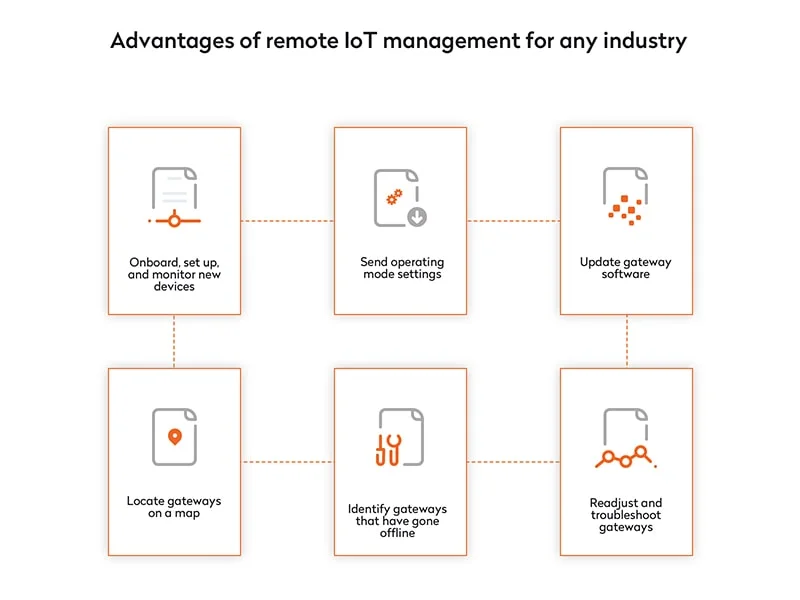
How the cloud helps to ensure remote management IoT networks
Leading cloud providers like AWS, Microsoft Azure, and Google Cloud offer specialized cloud infrastructure and approaches to organizing remote IoT network management. These systems are called IoT management platforms, and they provide users with the following benefits.
Smooth synchronization between software and hardware
Along with data centers, cloud providers allow their customers to use a range of services for IoT infrastructure maintenance. These services help to ensure quality synchronization between software and physical devices. For example, AWS provides its IoT Device Shadow service.
As part of this service, a so-called “shadow” is assigned to each gateway in a network. This shadow is literally a cloud infrastructure counterpart of a particular device. The shadow constantly synchronizes with its device and has a list of all parameters that need to be set. Respectively, the gateway reports to the shadow the gateway’s current settings and statistics, while the shadow sends updates to the gateway.
Automated gateway setup and maintenance
Before moving to the cloud, technologies didn’t allow for automated multiple gateway management. But manually setting up large sets of gateways one by one is extremely time-consuming.
Cloud technology helps an organization see all its gateways and ensure various business flows. These flows may include combining gateways in networks and tagging gateways to group them by different parameters (indoor or outdoor, with or without a GPS module, old or new). Through grouping gateways by different parameters, an organization can perform large-scale setup in just one click.
An IoT manufacturer can see all gateways it has produced and perform emergency firmware updates if vulnerabilities are detected. In turn, customers can download firmware updates from a centralized place.
High fault tolerance
Gateways might periodically go offline due to signal fluctuations. However, if a gateway is offline when settings are sent, those settings will not be received by the gateway. A cloud system that’s available 24/7, however, can receive and record all data. When the gateway comes back online, it can synchronize with the cloud to get all the updates it missed.
To benefit from the abovementioned advantages, an IoT provider needs to follow the cloud migration strategy we talk about next.
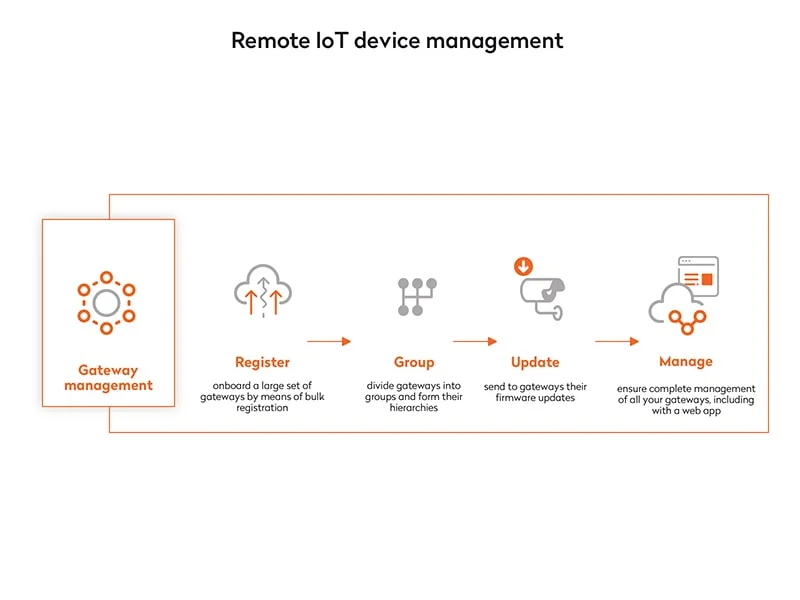
How to manage IoT devices remotely
IoT vendors like RAKwireless, Wanesy Management Center, and Gemtek have already managed to provide their customers with remote IoT device management platforms. Such IoT providers also enable customers to perform automated gateway setup and maintenance. This is especially helpful for large organizations that manage multiple large-scale and fast-growing networks of remote internet access IoT devices in different locations.
Such software solutions are tailored to network administration experts not requiring specialists with IoT infrastructure expertise within an organization. These IoT remote management solutions incorporate ready-to-use tools for managing IoT infrastructure.
To ensure such IoT network management, an IoT provider needs to take three important steps. Let’s look at them one by one.
Step 1. Expand your IoT infrastructure
As a starting point, an IoT provider might have only hardware infrastructure. The provider may manufacture gateways and have an R&D department that develops firmware — software installed on a gateway’s memory chip that turns the gateway into a smart device. To expand this infrastructure, an IoT provider starts using an IoT management platform offered by a cloud provider.
Step 2. Ensure synchronization between the cloud and gateways
Although an IoT management platform like AWS provides tools for ensuring synchronization, your gateway firmware needs to know its shadow, how to accept settings from it, how to report data to it, and how to perform this synchronization in a reliable, secure manner.
This requires you to tune your gateway firmware and set up cloud services to enable two-way synchronization, as this service usually isn’t offered by a cloud provider. Independent technology providers with IoT expertise like Yalantis can set up your IoT management platform.
Enabling synchronization between a cloud service and gateways allows any external software service — for example, a gateway onboarding platform — to communicate with a gateway. This is ensured via the cloud service, which is always online and whose connection rules are clear.
When you’ve achieved the goal of quality synchronization between the cloud, shadows, and your gateways, proceed to the next step.
Read also: The variety of our IoT-related services
Step 3. Enable users to remotely manage their gateways
An IoT provider needs to offer customers an effective tool for easy IoT network management. This tool should help network administrators from the customer’s side manage all the company’s IoT networks. Such a remote IoT management system has to:
- have specific features like different scales of device maintenance
- offer reporting capabilities and troubleshooting tools
- be secure by providing audit logs and user permissions
We developed such a user-facing remote IoT control system for RAKwireless. The SaaS web application interacts with our client’s IoT management ecosystem through the AWS IoT Core message broker. New gateways auto-provision to AWS IoT Core and provide technical characteristics that help users locate, onboard, and configure gateways. Users can remotely update gateways and receive near real-time alerts if their equipment goes offline.
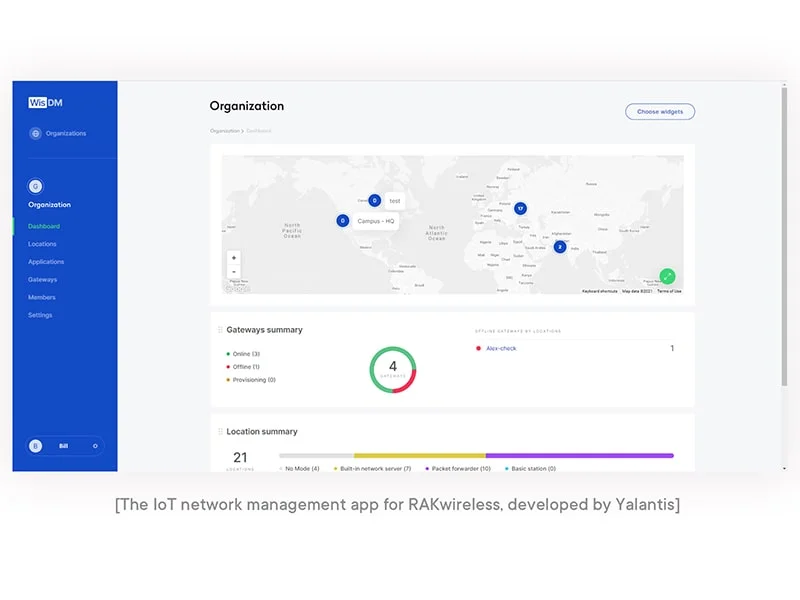
During cloud migration and when building a user-facing app, you’re likely to face a few challenges. Let’s consider them and possible solutions to solve them.
Based on our valid expertise, we have created an article about the SaaS migration strategy that may be useful to you.
Challenges you might encounter as you manage IoT devices remotely
How to control IoT devices in a secure and reliable manner? Enabling your customers to take advantage of remote IoT management is a challenging task with lots of hidden pitfalls. In general, they are related to the following aspects.
Ensuring data security
Before moving to the cloud, you had to be close to a gateway and know its local password to manage it. But with the cloud, your system becomes vulnerable to cyber attacks and viruses. In addition to implementing strict user permissions dictating which user can detect and manage a particular gateway, consider these practices.
To enable a gateway to securely communicate with the cloud, you should establish a secure communication channel. One way to do this is to exchange certificates between a gateway and the cloud. Thereby, other hardware can’t address the cloud provider’s account because it lacks the correct certificate.
To establish a secure channel between the cloud and a client-facing app, your gateway should be able to auto-provision, register in the cloud, and ask the cloud for service. Then the end user needs to be able to onboard their gateway via the user-facing app. To do that, the user enters the gateway’s unique serial number into the system. To help the user prove their gateway ownership, IoT providers implement various approaches. They might include adding a field to a gateway interface where a user has to enter a unique buyer ID or accompanying the gateway serial number with an additional key.
Enabling asynchronous/synchronous interactions
Your web platform should support both asynchronous and synchronous interactions, since gateway setup performed via the cloud is partially asynchronous. When the cloud-facing platform communicates with the cloud, it accepts data and requires you to wait until the cloud sends data to the gateway.
But it’s often impossible to implement standby mode within the platform architecture (for example, in case of using the serverless approach). To enable asynchronous interactions for the RAKwireless app, we ensured continuous bidirectional gateway data synchronization based on AWS IoT Core shadows and adding specific business logic flows.
Peculiarities of the web platform architecture
While designing a web platform architecture, you should consider not only support for asynchronous/synchronous interactions. As IoT equipment has limited computing power, it can take a long time to do things like apply lots of settings on the hardware device side. Such long operations might exceed the existing cloud API gateway timeout.
For the RAKwireless web app, we built an architecture based on serverless Lambda that ensures additional mechanisms for supporting long-running operations. To meet the AWS API timeout requirements, we used job processing and polling mechanisms.
If you choose to implement a serverless architecture to make the system cost-efficient, keep in mind that this type of architecture is challenging for ensuring long-running operations, asynchronous operation support, security, and fault tolerance. These challenges make developers come up with non-standard architectural mechanisms.
We hope this post on how to manage remote IoT networks was helpful. If you decide to cooperate with a technical partner to provide your customers with quality remote IoT management services, make sure your partner knows how to handle the pitfalls associated with implementing the solution we described in this post. We have been helping IoT solution providers for years. Check out how we provided one of our such clients with long-term team augmentation services. Our technical team will gladly help you expand your IoT consulting services and successfully enter the enterprise segment of the IoT market.
FAQ
How can you ensure remote management of IoT devices?
IoT device management is performed by accessing IoT devices in order to track and manage their functioning distantly. This can be done using IoT device management software. It helps to remotely reveal problems with particular parts of equipment to be examined and solved before they affect the entire system. In the absence of effective IoT remote management software, businesses can’t use their IoT devices effectively and monitor the system’s operational status.
What capabilities does an IoT remote management tool have to offer?
Such a solution has to allow you to quickly onboard, locate, monitor, set up, update, and troubleshoot devices at different scales in large IoT networks. The last can be performed thanks to near-real-time alerts if equipment goes offline.
Why choose Yalantis to build an IoT remote management system?
We are experienced in IoT platform development, cloud IoT migration, and enabling IoT analytics. Specifically, we build device management platforms that facilitate setup and maintenance of large IoT networks. Check out our IoT expertise, case studies, and clients’ reviews to explore our polished IoT software development processes, our IoT products’ capabilities, and the project results.
Rate this article
5/5.0
based on 1,135 reviews


